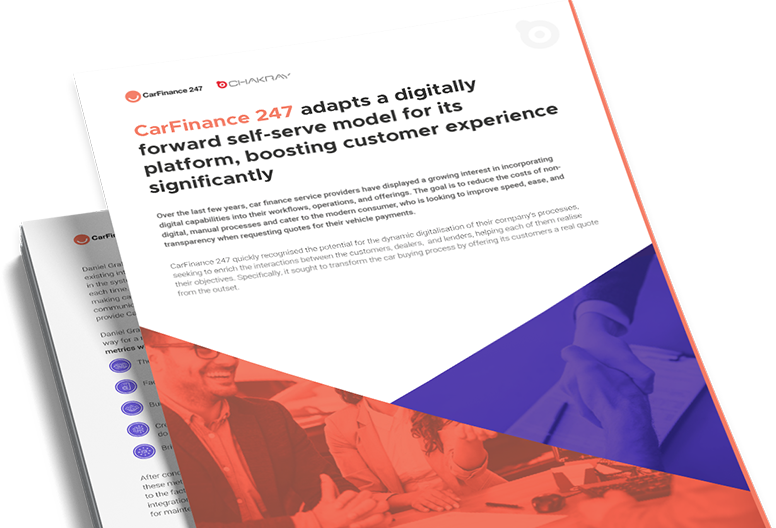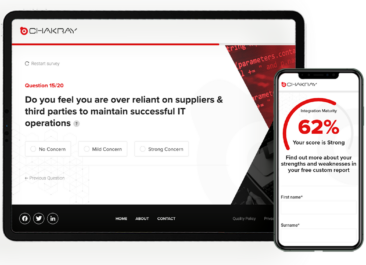
Introduction
Over the last few years, car finance service providers have displayed a growing interest in incorporating digital capabilities into their workflows, operations, and offerings. The goal is to reduce the costs of nondigital, manual processes and cater to the modern consumer, who is looking to improve speed, ease, and transparency when requesting quotes for their vehicle payments.
CarFinance 247 quickly recognised the potential for the dynamic digitalisation of their company’s processes, seeking to enrich the interactions between the customers, dealers, and lenders, helping each of them realise their objectives. Specifically, it sought to transform the car buying process by offering its customers a real quote from the outset.
Daniel Graham, the CTO of CarFinance 247, immediately recognized the need for a centralised version of preexisting integrations within their platform. This solution will lead to a faster incorporation of business changes in the system; for instance, new financial providers can be added without tampering with the integration logic each time. The intention behind this platform is to help consumers achieve a level of independence when making car financing decisions. This is done by implementing a self-serve functionality whilst keeping their communications with lenders and dealers intact. Therefore, he invited Chakray to join this project, in order to provide CarFinance 247 all of the above.
Daniel Graham reinforced that the company has always applied a consumer-focused approach, paving the way for a multi-channel car financing solution tailored to the modern user. According to him, some of the key metrics which are useful for analysing the project are:
- The extent to which legacy code is refreshed and a clean design approach is adapted.
- Facilitating traceability, ease of change, and ease of deployment.
- Building good relationships with lenders.
- Creating separation between integrations with lender technologies. Although all lender integrations do the same thing, having this separation can ease the addition of new lenders to the platform.
- Bringing uniformity to lender integrations.
After conducting technology reviews, the CarFinance 247 and Chakray team agreed that the best way to meet these metrics was to implement a solution with a single API. The chosen technology stack was Azure, owing to the fact that the company was already familiar with the platform’s services. Moreover, the ability to reuse integration components within Azure as well as its consumption-based pricing model makes it a fitting choice for maintenance purposes.

The Solution
The suggested solution aims to replace the custom-coded integrations that connected the company’s internal systems and the lender APIs with a consistent API facade. This method allows the CarFinance 247’s system to consume the APIs used by the lenders in collaboration with them. This design pattern follows a two-layer architecture. The first layer is an API implementation that exposes a single data model working to hide the complexities of each lender API. It collects all API requests from CarFinance 247’s platform and passes them to the second layer, where the initial request is transformed into a format that is readable to the consuming applications.
This API facade thus centralises and standardises the process of receiving requests from the CarFinance 247 platform, which means that adding new integrations becomes a more modular and decoupled procedure. Altogether, this impacts scalability positively. Each new lender integration can be added to the second layer without disturbing any existing integrations. If one of the lender integrations fails temporarily, this design will guarantee that the solution as a whole carries on functioning as intended. This helps enhance the overall flexibility and scalability of the system as it allows CarFinance 247 to promptly tackle business changes, debug key issues, and fit new integrations into the architecture when necessary.
The two layers are bridged using a service bus, particularly the one provided by Azure. Its main purpose is to sever the front-end and back-end logic from one another; this is the principle behind the API facade. Some of the other components of this architecture are:
- API Management: Provides API gateways for internal requests and defines policies to supervise communication with other third party APIs in REST and SOAP format
- Logic Apps: A platform that facilitates automated workflows for each integration
- Cosmos DB: a serverless database that is fully managed and provided by Azure. It seamlessly connects to the logic apps platform and authorises the handling of external queries
Dan Graham noted that Chakray was doing a great job with the digital transformation involved in the project so far. Similarly, one of CarFinance 247’s key lenders that has recently undergone the development phase with Chakray’s integration team—said: “Great work so far within the test cases submitted so far, we are happy with those for Quote, Full Application and Contract acceptance.” Given the success of the project so far, CarFinance 247 wishes to maintain their relationship with Chakray, especially along the lines of licensing and managed services.

Outcomes
Despite delays that caused some of the lender integrations to be shelved or deprioritised, a good number of them have gone live as of November 2022. MotoNovo, one of the prime lenders for the company, went live in March 2022 and has since then advanced the turnover of the business. With live lenders on CarFinance 247’s platform, the complex process of applying for car loans is refined, contributing to better user experience. The project is still ongoing and more lenders are set to launch. With the right resources and conditions in place, the deployment of lender integrations could take anywhere from 4-6 weeks; this could lead to a rapid scale-up of the number of deals CarFinance 247 strikes per day.
Some of the outcomes that the project has accomplished:
- Creating a platform that provides the best available quote for every one of the 120,000 vehicles catalogued on their platform, personalised to the buyer’s priorities. Since customers are kept informed about the monthly costs from the start, they avoid being blindsided later in their car-buying journey. This was achieved through their network of lenders who assist customers in choosing the right financing options.
- Creating a platform where car dealers can list their vehicles for free. They can expect to be contacted by individuals from a pool of 62,000 buyers, all of whom are already sanctioned for financing and eager to purchase their next car. Currently, CarFinance 247 works with a panel of 4000 dealers.
- Creating an ecosystem for rapid scale-ups. With this platform, CarFinance 247 can make hundreds of deals per day, which can amount to £800,000 in revenue from a single lender. The first three lenders that went live on the platform amount to 40% of CarFinance 247’s volume, thus boosting profitability.
- Creating a holistic ecosystem that breaks down barriers to purchasing a car, tightening the relationship between buyers, sellers, and lenders, ultimately increasing customer satisfaction across the board.
- Creating a platform that implements manual car financing activities as self-serve functionalities. In many cases, transferring processes such as loan applications, car searches, and purchase agreements to the electronic medium eliminates the middleman (account manager) and saves time.
- Creating a platform that leverages technology to cater to the present-day consumer by providing them with a digital-first experience.
- Creating a platform that follows the framework of online shopping websites and fintech banking services that enable real-time monetary transactions and commercial activities that are customised to each individual.
Daniel Graham, CTO of 247 Group, aptly describes the company’s platform: “Our pioneering new user interface is designed to be the smoothest and simplest used car financing platform in the UK. Our platform reinforces trust in the market, engages in responsible lending, and tailors everything, from the finance product to the car buying experience, to each individual consumer.”
Similarly, Reg Rix, CEO of 247 Group, added: “When building CarFinance 247 into the market-leading platform it is today, our focus has always been on improving the experience of everyone who interacts with our services. We are committed to making it easier for dealerships to sell cars by connecting them to pre-approved buyers while also providing consumers with more choice and peace of mind when looking for their perfect car.”

About the project
The Technology
The following technologies were required to deliver the desired outcomes:
About CarFinance 247
CarFinance 247 is a pioneer in the domain of auto loans and financing. Their goal is to simplify the process that customers have to experience before and whilst buying a car. Their car financing platform aims to provide agency to individual buyers and establish secure pathways of communication between them, the sellers, and finance providers that make purchasing a car possible.
Visit Client Website








